Fire Management in Mount Kenya: A Case Study of Gathiuru Forest Station
Abstract
:1. Introduction
2. Integrated Fire Management Framework
3. Materials and Methods
3.1. Description of the Study Site: Gathiuru Forest Station
3.2. Methods for Analysing the Conditions
3.2.1. Feasibility Study
3.2.2. Questionnaires
3.2.3. Focus Group Discussions
3.2.4. Ranking of Benefits and Concerns in Gathiuru Forest
4. Results
4.1. Humans Needs and Benefits in Gathiuru Forest
4.2. Human Activities and Their Influence on Fire Ignition in Gathiuru Forest
4.2.1. Perception about Factors Influencing Fire Ignition
4.2.2. Legal Human Activities in Gathiuru Forest
4.2.3. Illegal Activities in Gathiuru Forest
4.3. Concerns Related to Fires
4.4. Implementation of Integrated Fire Management
4.4.1. Stakeholder Involvement
4.4.2. Provision of Fire Training and Technical Support to Improve IFM
4.4.3. Existence and Revision of IFM Plans
4.4.4. Land Use and Fire Danger Rating in Gathiuru Forest
5. Discussion
5.1. Land Use Practices and Fire Ignition
5.2. Positive Social and Environmental Benefits of Precsribed Fires
5.3. Negative Social and Environmental Effects of Catastrophic Fires
5.4. External Drivers Influencing Fire Danger
6. Conclusions
Author Contributions
Funding
Acknowledgments
Conflicts of Interest
Appendix A
| Stakeholder | Interests | Activities | Strengths | Weaknesses |
|---|---|---|---|---|
| KFS | Protection and conservation of forests | -tree planting, establishment of tree nurseries, revenue collection, awareness creation, carrying out patrols, zonation/mapping of forest areas, enforcing forest law and policy | -Forest Act and policy -expertise -support from lobby groups and donors | -inadequate machinery and equipment, inadequate staff, political interference, inefficiency among KFS staff |
| KWS | Protection and conservation of wildlife | -electric fencing, promotion of tourism, patrolling, enforcement of the wildlife act, establishment of tree nurseries, translocation of wildlife, information dissemination | -Forest Act and policy, Wildlife Act and policy, expertise, support from lobby groups and donors, adequate resources | -poor response to incidences, poor compensation laws, poor collaboration with the community |
| Saw millers | Profit making | -logging, conversion of logs to timber products, creation of employment, selling timber based products | -have money, Forest Act and policy | -They do not plant trees, illegal access to trees, big contributors to environmental degradation |
| CFA | Protection and conservation of the forest for community benefits | -tree planting, establishment and management of tree nurseries, controlling forest fires, community policing, generating revenue for the government, managing forest resources | -support from KFS, Forest Act and policy, support from community, support from donors and lobby groups | -lack of finances, poor awareness of CFA activities, among the community members, lack of commitment from CFA officials |
| Greenbelt Movement | Increased tree cover | -tree planting -promoting community awareness -funding tree planting activities | -community support, support from lobby groups, forest act and policy, have expertise | -failure to fulfil promises -top-down approach in project activities implementation |
| Nature Kenya | Conservation of the biodiversity | -awareness creation | -adequate resources, support from government bodies such as KWS & KFS, have expertise | -not well known by the community, ineffective community outreach programme |
| BRWUA | Management and conservation of Burguret River | -supplying water tanks, regulation of water use, supplying drip kits, construction of water pans, construction of foot bridges and livestock watering troughs, tree planting on riparian land | -water act 2002 -support from water users -support from NGOs -support from KFS | -failure to fulfil promises -poor community representation -lack of direct link between BRWUA and the beneficiaries |
| TIST | Mitigation against climate change | “Promoting” tree planting | -has international funding | -not well known by the community |
| LWF | Environmental conservation | -creating awareness, funding CBOs | -have adequate financial resources, have expertise | -not known to the community, poor community representation |
| Ministry of Agriculture | Food security & facilitating agro-business | -offering extension services | -Government policy, support from the community, have expertise | -inadequate staff |
| Ministry of Defense | Defending the country | -tree planting, road and bridge construction -water abstraction from Rongai River | -Government policy, have adequate machinery &equipment | None |
| Ministry of Fisheries & Livestock | Promotion of livestock development | -offer extension services -treatment and vaccination | -have expertise -Government policy | -inadequate staff -services are expensive |
| Bantu Lodge | Profit making | -tourism -entertainment | -have money, support from Government, create employment | -No tree planting, no community involvement, poor security |
| UNDP-GEF | Environmental conservation | -establishment of tree nurseries, funding community groups, awareness creation on environmental conservation | -have funds, support from the international community, Government support through KFS and KWS | -lack of follow up project implementation activities, not well known by the community |
References
- Laris, P.; Wardell, D.A. Good, bad or ‘necessary evil’? Reinterpreting the colonial burning experiment in the savanna landscapes of West Africa. Geogr. J. 2006, 172, 271–290. [Google Scholar] [CrossRef]
- Aragón, R.; Morales, J.M. Species composition and invasions in NW Argentinian secondary forests, Effects of land use history, environment and landscape. J. Veg. Sci. 2003, 14, 195–204. [Google Scholar] [CrossRef]
- Eriksson, O.; Cousins, S.A.; Bruun, H.H. Land-use history and fragmentation of traditionally managed grasslands in Scandinavia. J. Veg. Sci. 2002, 13, 743–748. [Google Scholar] [CrossRef]
- Nyongesa, K.W. Fire management if Forests and National Parks of Kenya: Case studies at Kakamega, Mt. Elgon and Mt. Kenya Forest and National Park. In Forestry, 1st ed.; Ivan, G., Ed.; OmniScriptum Publishers: Saarbrücken, Germany, 2015; pp. 1–124. ISBN 978-3-639-79212-6. [Google Scholar]
- Downing, T.A.; Imo, M.; Kimanzi, J. Fire occurrence on Mount Kenya and patterns of burning. GeoResJ 2017, 13, 17–26. [Google Scholar] [CrossRef]
- Seijo, F.; Millington, J.D.A.; Gray, R.; Sanz, V.; Lozano, J.; García, S.F.; Sangüesa, B.G.; Julio, C.J. Forgetting fire: Traditional fire knowledge in two chestnut forest ecosystems of the Iberian Peninsula and its implications for European fire management policy. Land Use Policy 2015, 47, 130–144. [Google Scholar] [CrossRef] [Green Version]
- Flatley, W.T. Fire Regimes of the Southern Appalachian Mountains: Temporal and Spatial Variability and Implications for Vegetation Dynamics. Ph.D. Thesis, Texas A&M University, College Station, TX, USA, December 2012. [Google Scholar]
- Sally, A.A.; Carla, S.; Simon, A.L. Evolution of human-driven fire regimes in Africa. Ecol. 2012, 109, 847–852. [Google Scholar] [CrossRef]
- GoK (Government of Kenya). Mt. Kenya Forest Reserve Management Plan 2010–2019. Available online: http://www.kenyaforestservice.org/documents/MtKenya.pdf (accessed on 31 August 2017).
- Imo, M.; Imo, M. Forest degradation in Kenya: Impacts of social, economic and political transitions. In African Political, Economic and Security Issues, 1st ed.; Adoyo, J.W., Wangai, C.I., Eds.; Nova Science Publishers: New York, NY, USA, 2012; pp. 1–38. ISBN 9781620810859. [Google Scholar]
- Dube, O.P. Linking fire and climate: Interactions with land use, vegetation, and soil. Curr. Opin. Environ. Sustain. 2009, 1, 161–169. [Google Scholar] [CrossRef]
- GoK (Government of Kenya). National Climate Change Action Plan 2013–2017. Available online: https://cdkn.org/wp-content/uploads/2013/03/Kenya-National-Climate-Change-Action-Plan.pdf (accessed on 31 August 2017).
- Aguilar, S.; Montiel, C. The challenge of applying governance and sustainable development to wildland fire management in Southern Europe. J. For. Res. 2011, 22, 627–639. [Google Scholar] [CrossRef] [Green Version]
- Gadgil, M.; Rao, P.R.S.; Utkarsh, G.; Pramod, P.; Chhatre, A. New meanings for old knowledge: The people’s biodiversity registers program. Ecol. Appl. 2000, 10, 1307–1317. [Google Scholar] [CrossRef]
- Bollig, M.; Sculte, A. Environmental Change and Pastoral Perceptions: Degradation and Indigenous Knowledge in Two African Pastoral Communities. Hum. Ecol. 1999, 27, 493–514. [Google Scholar] [CrossRef]
- Butz, R.J. Traditional fire management: Historical fire regimes and land use change in pastoral East Africa. Int. J. Wildland Fire 2009, 18, 442–450. [Google Scholar] [CrossRef]
- FAO (Food and Agriculture Organization of the United Nations). Fire Management Voluntary Guidelines-Principles and Strategic Actions. 2006. Available online: http://www.fao.org/docrep/009/j9255e/j9255e00.htm (accessed on 31 August 2017).
- British Columbia. Wildland Fire Management Strategy. 2010. Available online: http://www2.gov.bc.ca/assets/gov/farming-natural-resources-and-industry/forestry/wildfire-management/governance/bcws_wildland_fire_mngmt_strategy.pdf (accessed on 15 May 2018).
- Wangari, F. The Effects of Fires on Plants and Wildlife Species Diversity and Soil Physical and Chemical Properties at Aberdare Ranges, Kenya. Master’s Thesis, University of Nairobi, Nairobi, Kenya, 2016. [Google Scholar]
- Vale, T.R. The pre-European landscape of the United States: Pristine or humanized? In Fire, Native Peoples, and the Natural Landscape; Vale, T.R., Ed.; Island Press: Washington, DC, USA, 2002; pp. 1–39. ISBN1 1597266027. ISBN2 9781597266024. [Google Scholar]
- Downing, T.A.; Imo, M.; Kimanzi, J.; Otinga, A.N. Effects of wildland fire on the tropical alpine moorlands of Mount Kenya. CATENA 2017, 149, 300–308. [Google Scholar] [CrossRef]
- Heydari, M.; Faramarzi, M.; Pothier, D. Post-fire recovery of herbaceous species composition and diversity, and soil quality indicators one year after wildfire in a semi-arid oak woodland. Ecol. Eng. 2016, 94, 688–697. [Google Scholar] [CrossRef]
- Wade, D.D.; Lundsford, J. Fire as a Forest Management Tool: Prescribed Burning in the Southern United States. Available online: http://www.fao.org/docrep/t9500e/t9500e07.htm (accessed on 24 July 2018).
- KFS (Kenya Forest Service). Participatory Forest Management Plan for Gathiuru Forest. Available online: http://xa.yimg.com/kq/groups/23491130/1315364834/name/Gathiuru (accessed on 31 August 2017).
- Matthew, W. Bushfires—How can we avoid the unavoidable? Glob. Environ. Chang. Part B Environ. Hazards 2005, 6, 93–99. [Google Scholar] [CrossRef]
- Rodríguez-Trejo, D.A. Fire regimes, fire ecology, and fire management in Mexico. Ambio 2008, 37, 548–556. [Google Scholar] [CrossRef] [PubMed]
- Cochrane, M.A.; Hoffmann, A.A.; Parry, J.E.; Cuambe, C.C.D.; Kwesha, D.; Zhakata, W. Climate change and wildland fires in Mozambique. Trop. Fire Ecol. 2009, 227–259. [Google Scholar] [CrossRef]
- Mistry, J.; Berardi, A.; Andrade, V.; Krahô, T.; Krahô, P.; Leonardos, O. Indigenous fire management in the cerrado of Brazil: The case of the Krahô of Tocantíns. Hum. Ecol. 2005, 33, 365–386. [Google Scholar] [CrossRef]
- Myers, R.L. Living with Fire-Sustaining Ecosystems & Livelihoods Through Integrated Fire Management. Available online: https://www.frames.gov/catalog/701 (accessed on 31 August 2017).
- Grau, H.R.; Gasparri, N.I.; Aide, T.M. Balancing food production and nature conservation in the Neotropical dry forests of northern Argentina. Glob. Chang. Biol. 2008, 14, 985–997. [Google Scholar] [CrossRef]
- Obare, L.; Wangwe, J.B. Underlying Causes of Deforestation and Forest Degradation in Kenya. Available online: http://www.wrm.org.uy/oldsite/deforestation/Africa/Kenya.html (accessed on 31 August 2017).
- FAO (Food and Agriculture Organization of the United Nations). A Decade of Wood Energy Activities within the Nairobi Programme of Action. 1997. Available online: http://www.fao.org/docrep/T0747E/t0747e02.htm (accessed on 31 August 2017).
- Fuwape, J.A. Secondary forests and fuel wood utilization in Africa. In Silviculture in the Tropics; Springer: Heidelberg, Germany, 2011; Volume 8, pp. 369–376. [Google Scholar]
- CIFOR. Firewood Collection Taking a Toll on Uganda’s Forests. 2016. Available online: https://forestsnews.cifor.org/41271/firewood-collection-taking-a-toll-on-ugandas-forests?fnl=en (accessed on 31 August 2017).
- Sassen, M.; Sheil, D.; Giller, K.E. Fuelwood collection and its impacts on a protected tropical mountain forest in Uganda. For. Ecol. Manag. 2015, 354, 56–67. [Google Scholar] [CrossRef]
- Humphrey, J.W.; Patterson, G.S. Effects of late summer cattle grazing on the diversity of riparian pasture vegetation in an upland conifer forest. J. Appl. Ecol. 2000, 37, 986–996. [Google Scholar] [CrossRef] [Green Version]
- Blackmore, M.; Vitousek, P.M. Cattle grazing, forest loss, and fuel loading in a dry forest ecosystem at Pu’u Wa’awa’a Ranch, Hawaii. Biotropica 2000, 32, 625–632. [Google Scholar] [CrossRef]
- Roder, W.; Gratzer, G.; Wangdi, K. Cattle Grazing in the Conifer Forests of Bhutan. Mt. Res. Dev. 2002, 22, 368–374. [Google Scholar] [CrossRef]
- Stern, M.; Quesada, M.; Stoner, K.E. Changes in composition and structure of a tropical dry forest following intermittent cattle grazing. Rev. Biol. Trop. 2002, 50, 1021–1034. [Google Scholar] [PubMed]
- Savadogo, P.; Sawadogo, L.; Tiveau, D. Effects of grazing intensity and prescribed fire on soil physical and hydrological properties and pasture yield in the savanna woodlands of Burkina Faso. Agric. Ecosyst. Environ. 2007, 118, 80–92. [Google Scholar] [CrossRef]
- Verschuuren, B.; Wild, R.; McNeely, J.A.; Oviedo, G. Sacred Natural Sites: Conserving Nature and Culture, 1st ed.; Earthscan: London, UK, 2010; pp. 2–10. ISBN 9781849711661. [Google Scholar]
- Muriuki, J. Medicinal Trees in Smallholder Agroforestry Systems: Assessing Some Factors Influencing Cultivation by Farmers. Ph.D. Thesis, University of Natural Resources and Life Sciences (BOKU), Vienna, Austria, January 2011. [Google Scholar]
- Acquah, E.; Nsor, C.A.; Arthur, E.K.; Boadi, S. The Socio-Cultural Impact of Ecotourism on Park-Adjacent Communities in Ghana. Afr. J. Hosp. Tour. Leis. 2017, 6, 1–14. [Google Scholar]
- Ogato, G.S. Planning for Sustainable Tourism: Challenges and Opportunities for Ecotourism Development in Addis Ababa, Ethiopia. Am. J. Hum. Ecol. 2014, 3, 20–26. [Google Scholar] [CrossRef]
- Vishwanatha, S.; Chandrashera, B. An Analysis of Socio-Cultural Impacts of Ecotourism in Kodagu District. Am. J. Res. Commun. 2014, 2, 135–147. [Google Scholar]
- Global Fire Monitoring Center. Wildland Fire and Tourism Community-Based Fire Management (CBFiM). 2017. Available online: http://www.fire.uni-freiburg.de/Manag/TUI_1.htm (accessed on 31 August 2017).
- Eby, S.L.; Anderson, T.M.; Mayemba, E.P.; Ritchie, M.E. The effect of fire on habitat selection of mammalian herbivores: The role of body size and vegetation characteristics. Anim Ecol. 2014, 83, 1196–1205. [Google Scholar] [CrossRef] [PubMed]
- Dalu, M.T.; Dalu, T.; Wasserman, R.J. Africa: Restrict bush fires used in animal hunts. Nature 2017, 547, 281. [Google Scholar] [CrossRef] [PubMed]
- GoK (Government of Kenya). Mt Kenya Ecosystem Management Plan 2010–2020. Available online: www.kws.go.ke/sites/default/files/parksresorces%3A/Mt.%20Kenya%20Ecosystem%20Management%20Plan%20%282010-2020%29.pdf (accessed on 6 August 2018).
- Gupta, R.K.; Khan, M.S.; Srivastava, R.M.; Goswami, V. History of Beekeeping in Developing World, 1st ed.; Gupta, R., Reybroeck, W., van Veen, J., Gupta, A., Eds.; Springer: Dordrecht, The Netherland, 2014; pp. 3–62. ISBN 9789401791991. [Google Scholar]
- Bussmann, R.W. Succession and regeneration patterns of East African mountain forests A review. Syst. Geogr. Plants Geogr. 2001, 71, 959–974. [Google Scholar] [CrossRef]
- Gorte, R.W.; Bracmort, K. Forest Fire/Wildfire Protection. 2012. Available online: https://fas.org/sgp/crs/misc/RL30755.pdf (accessed on 31 August 2017).
- Dube, O.P. Challenges of wildland fire management in Botswana: Towards a community inclusive fire management approach. Weather Clim. Extrem. 2013, 1, 26–41. [Google Scholar] [CrossRef]
- Huffman, D.W.; Zegler, T.J.; Fulé, P.Z. Fire history of a mixed conifer forest on the Mogollon Rim, northern Arizona, USA. Int. J. Wildland Fire 2015, 24, 680–689. [Google Scholar] [CrossRef]
- Moira, C.W.; Glenda, M.W. Pinus radiata invasion in Australia: Identifying key knowledge gaps and research directions. Austral Ecol. 2007, 32, 721–739. [Google Scholar] [CrossRef]
- Filipe, X.C.; Francisco, M.; Rui, T.; Joaquim, S.S. Post-fire survival and regeneration of Eucalyptus globulus in forest plantations in Portugal. J. For. Ecol. Manag. 2013, 310, 194–203. [Google Scholar] [CrossRef]
- Moench, R.; Fusaro, J. Soil Erosion Control after Wildfire. 2012. Available online: http://extension.colostate.edu/docs/pubs/natres/06308.pdf. (accessed on 31 August 2017).
- Tecle, A.; Neary, D. Water Quality Impacts of Forest Fires. J. Pollut. Eff. Control 2015, 3, 140. [Google Scholar] [CrossRef]
- Kumssa, A.; Jones, J.F.; Herbert, W.J. Conflict and human security in the North Rift and North Eastern Kenya. Int. J. Soc. Econ. 2009, 36, 1008–1020. [Google Scholar] [CrossRef]
- Waal, H.O. Livestock Production during Drought. 2016. Available online: http://www.farmingportal.co.za/index.php/farming-interest/item/6137-livestock-production-during-drought?tmpl=component&print=1 (accessed on 31 August 2017).
- GoK (Government of Kenya). The Kenya Forest Act 2005. Available online: http://www.fankenya.org/downloads/ForestsAct2005.pdf (accessed on 31 August 2017).
- Thompson, L.G. Kilimanjaro Ice Core Records: Evidence of Holocene Climate Change in Tropical Africa. Science 2002, 298, 589–593. [Google Scholar] [CrossRef] [PubMed]
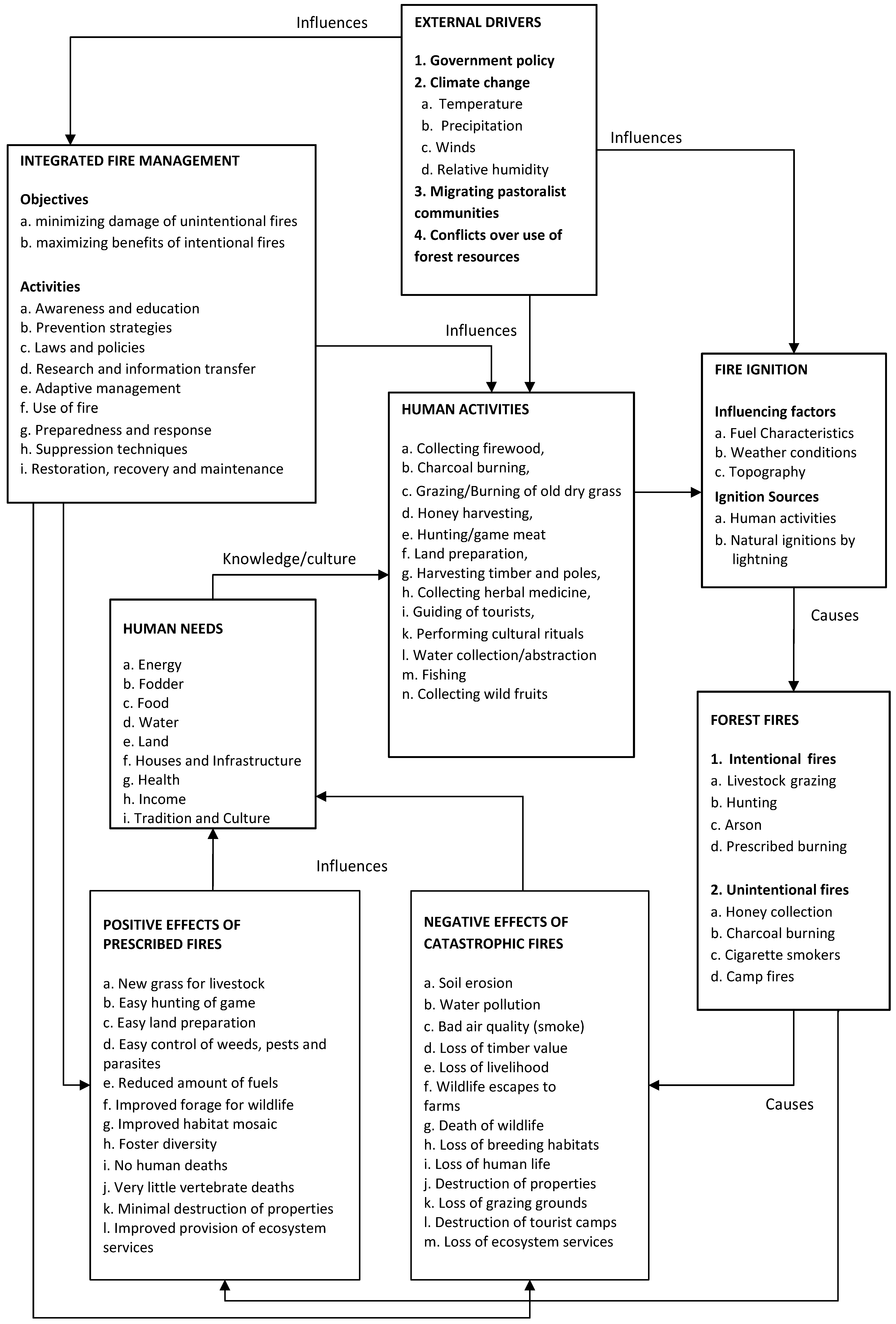
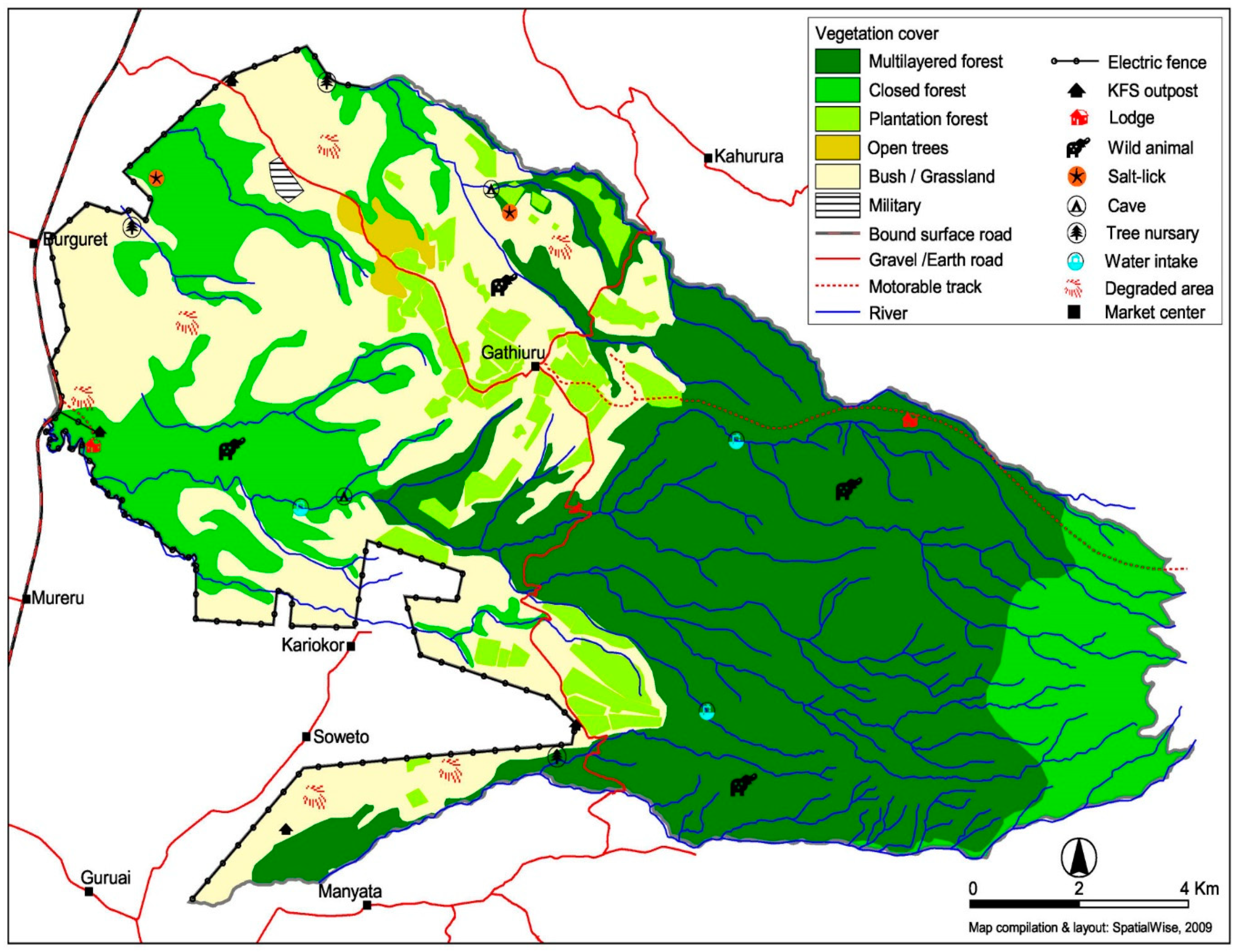
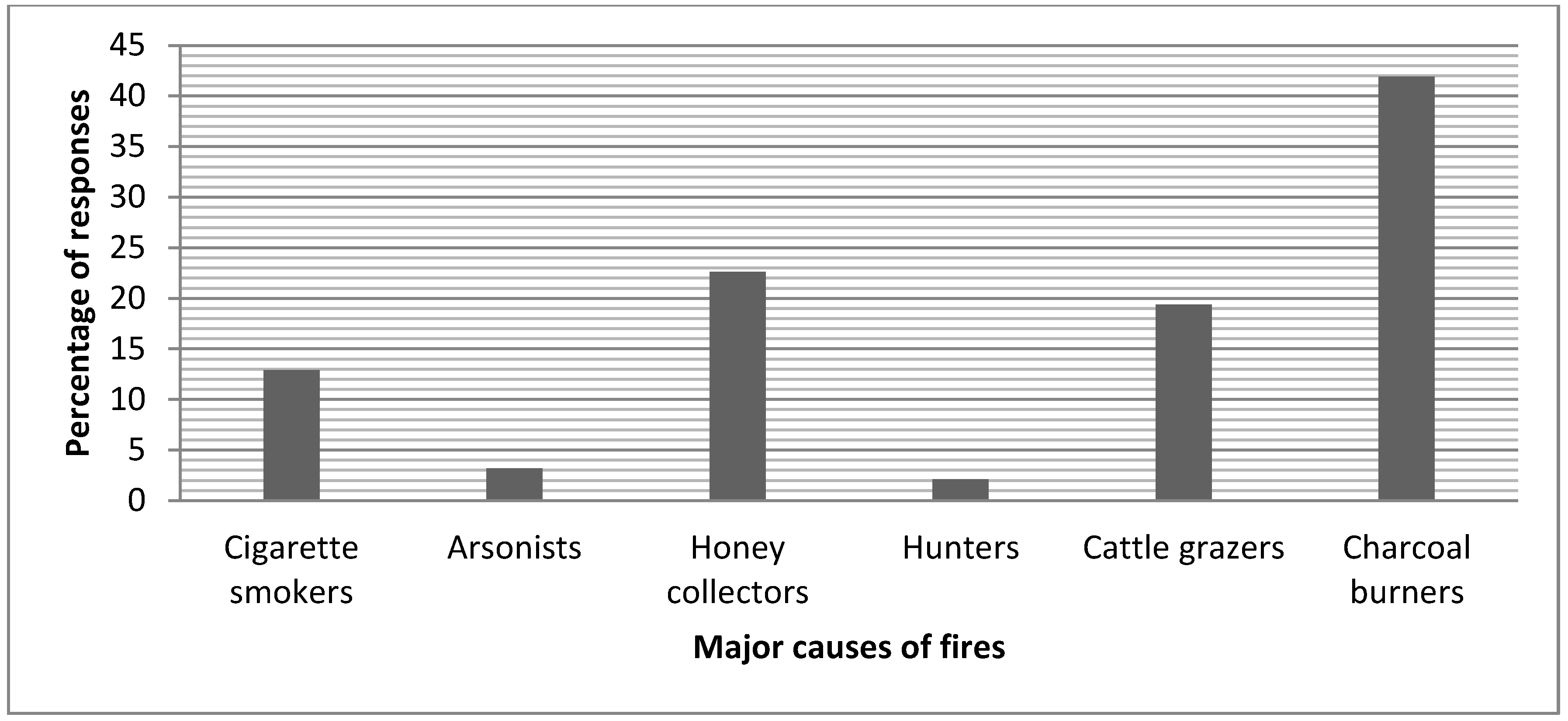
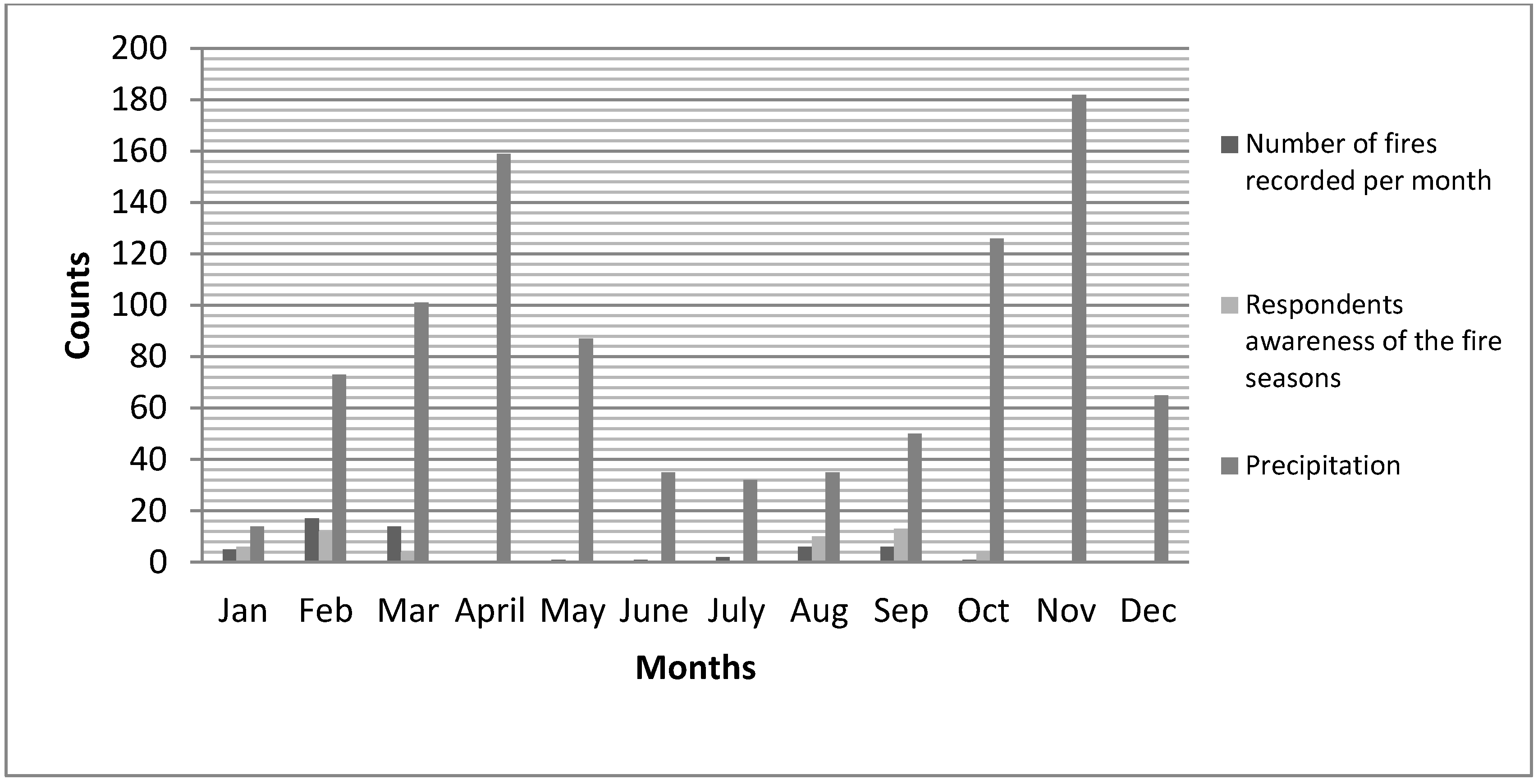
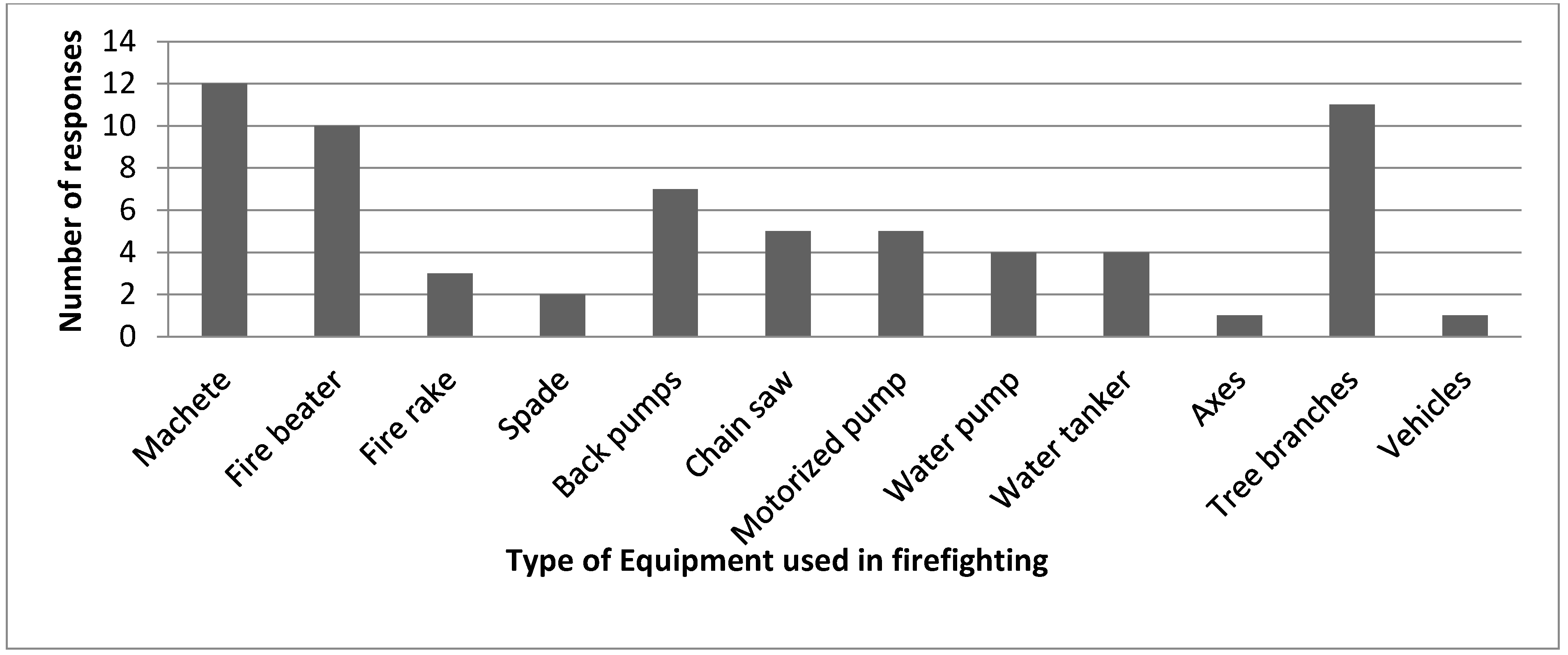
| Rank of Needs & Benefits | Benefit Class | Number of Votes for Benefits | Importance |
|---|---|---|---|
| Tally I & Tally II | |||
| 1 | Farmland (PELIS) | 17 | 0.71 |
| 2 | Water | 13 | 0.54 |
| 3 | Employment/income | 12 | 0.50 |
| 4 | Herbal medicine | 10 | 0.42 |
| 5 | Education & research | 9 | 0.38 |
| 6 | Timber | 8 (11) | 0.34 |
| 7 | Grazing | 8 (9) | 0.33 |
| 8 | Honey collection | 3 | 0.13 |
| 9 | Firewood | 2 | 0.08 |
| 10 | Cultural and religion | 1 | 0.04 |
| Rank of Concerns | Concerns | Number of Votes for Concerns | Importance |
|---|---|---|---|
| Tally I & Tally II | |||
| 1 | Loss of grazing grounds (pasture) | 9 | 0.38 |
| 2 | Loss of wildlife habitat/escape to farms | 6 | 0.25 |
| 3 | Loss of wildlife | 5 | 0.21 |
| 4 | Water pollution | 4 | 0.17 |
| 5 | Bad air quality | 3 (3) | 0.13 |
| 6 | Soil erosion | 3 (2) | 0.12 |
| 7 | Loss of life | 2 | 0.08 |
| 8 | Loss of livestock | 1 | 0.04 |
© 2018 by the authors. Licensee MDPI, Basel, Switzerland. This article is an open access article distributed under the terms and conditions of the Creative Commons Attribution (CC BY) license (http://creativecommons.org/licenses/by/4.0/).
Share and Cite
Nyongesa, K.W.; Vacik, H. Fire Management in Mount Kenya: A Case Study of Gathiuru Forest Station. Forests 2018, 9, 481. https://doi.org/10.3390/f9080481
Nyongesa KW, Vacik H. Fire Management in Mount Kenya: A Case Study of Gathiuru Forest Station. Forests. 2018; 9(8):481. https://doi.org/10.3390/f9080481
Chicago/Turabian StyleNyongesa, Kevin W., and Harald Vacik. 2018. "Fire Management in Mount Kenya: A Case Study of Gathiuru Forest Station" Forests 9, no. 8: 481. https://doi.org/10.3390/f9080481
APA StyleNyongesa, K. W., & Vacik, H. (2018). Fire Management in Mount Kenya: A Case Study of Gathiuru Forest Station. Forests, 9(8), 481. https://doi.org/10.3390/f9080481





